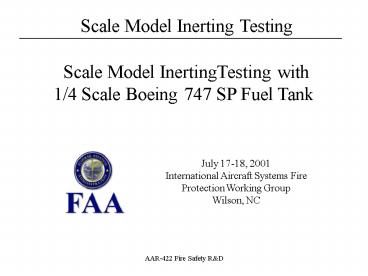Ground Based Fuel Tank Inerting - PowerPoint PPT Presentation
Title:
Ground Based Fuel Tank Inerting
Description:
Quarter Scale Model of Boeing 747 SP CWT was Built from Plywood By Scaling ... Model Results Consistent with Existing Knowledge Base But VTE Slightly Higher in ... – PowerPoint PPT presentation
Number of Views:58
Avg rating:3.0/5.0
Title: Ground Based Fuel Tank Inerting
1
Scale Model InertingTesting with 1/4 Scale Boeing
747 SP Fuel Tank
July 17-18, 2001International Aircraft Systems
FireProtection Working GroupWilson, NC
2
Background
- Inconsistent Comparisons of Test Data Created
Questions of NEA Required to Inert an Aircraft
Center Wing Tank - Focus of the Testing is to Better Determine the
Best Method to Inert a Compartmentalized Fuel
Tank - Study Equal NEA Distribution and Localized NEA
Deposit - Study Cross-Vented and Single Vent Configurations
- Develop Methods to Make Fair Comparisons.
3
Test Article
- Quarter Scale Model of Boeing 747 SP CWT was
Built from Plywood By Scaling Drawings from
Shepherd Report - 24 length Scale (1.2 Volume)
- Scaled all Bay-Bay Penetrations
- Variable Manifold Allows for Depositing NEA in
Any and All Bays of the Tank at Different Rates
to Support Inerting Times as Low as 10 Minutes - Oxygen Sensor in Each Bay and in One Vent Channel
4
Scale Model Bay Convention
Dry Bay
1
2
3
4
5
6
5
Preliminary Balanced Data
- Inerted Tank Several Times with NEA 95 and NEA
98 with the Goal of Balancing the Flow into
Inert Each Bay Equally for Standard
Cross-Venting Configuration - Acquired Data with a Stop Watch (1 reading per
minute) - Developed a Volumetric Average to Make
Comparisons with Other Inerting Runs - Results As Expected and Consistent with Previous
Testing but New Numbers Point Toward a VTE of 1.6
for 95 NEA - VTE Very Sensitive to O2 Concentration at 8 for
95 NEA
6
Preliminary Balanced Inerting Data
7
Preliminary Balanced Weighted Average Data
8
Preliminary Unbalanced Data
- Inerted Tank Several Times with NEA 95 with the
Goal of Minimizing the Volume Required to Inert
the Tank with Standard Cross-Venting
Configuration - Acquired Data with a Stop Watch (1 reading per
minute) - Used the Volumetric Average Developed to Make
Fair Comparisons with Other Inerting Runs - Results Illustrated Very Little Improvement in
VTE Required, but Allowed for Simpler Manifold
Designs - Smart Design as Good or Better then Well Balanced
Manifold
9
Preliminary Unbalanced Inerting Data
10
Preliminary Unbalanced Weighted Average Data
11
NEA Minimization Data
- Inerted Tank Several Times with NEA 95 to
Minimizing the NEA Volume Required to Inert the
Tank with Half Vent System Blocked (No Cross
Venting) - Acquired Data with Computer Data Acquisition
System at a Rate of 1 Sample per Second
(Approximate) - First did Balanced Run to Give Baseline Used
the Volumetric Average Developed to Make Fair
Comparisons with Other Inerting Methods - Results Illustrated Modest Improvement with
Simplest Deposit Scheme
12
NEA Minimization Data - Best Data
13
Unbalanced Weighted Average Data
14
Summary
- Model Results Consistent with Existing Knowledge
Base But VTE Slightly Higher in These Experiments - This is Believed to be due to Better Measurement
Techniques Developed - Depositing in an Efficient Manner Can Greatly
Simplify Manifold Design and Even Improve
Inerting Efficiency - Still Need to Verify Results in Full-Scale Test
Article































